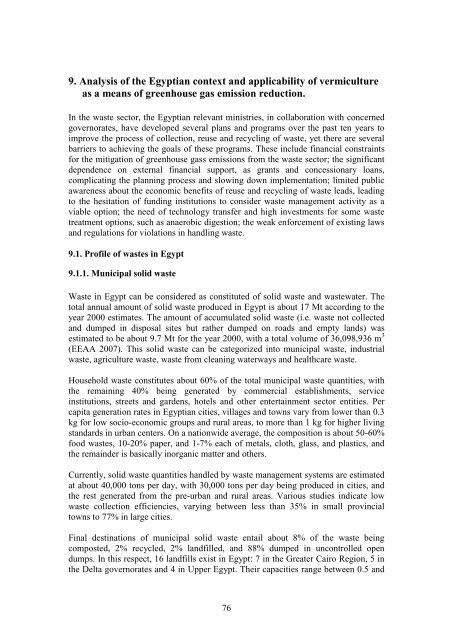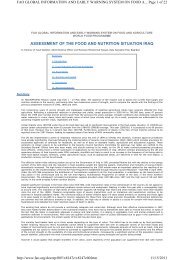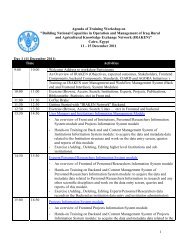Vermiculture in Egypt: - FAO - Regional Office for the Near East and
Vermiculture in Egypt: - FAO - Regional Office for the Near East and
Vermiculture in Egypt: - FAO - Regional Office for the Near East and
You also want an ePaper? Increase the reach of your titles
YUMPU automatically turns print PDFs into web optimized ePapers that Google loves.
9. Analysis of <strong>the</strong> <strong>Egypt</strong>ian context <strong>and</strong> applicability of vermiculture<br />
as a means of greenhouse gas emission reduction.<br />
In <strong>the</strong> waste sector, <strong>the</strong> <strong>Egypt</strong>ian relevant m<strong>in</strong>istries, <strong>in</strong> collaboration with concerned<br />
governorates, have developed several plans <strong>and</strong> programs over <strong>the</strong> past ten years to<br />
improve <strong>the</strong> process of collection, reuse <strong>and</strong> recycl<strong>in</strong>g of waste, yet <strong>the</strong>re are several<br />
barriers to achiev<strong>in</strong>g <strong>the</strong> goals of <strong>the</strong>se programs. These <strong>in</strong>clude f<strong>in</strong>ancial constra<strong>in</strong>ts<br />
<strong>for</strong> <strong>the</strong> mitigation of greenhouse gass emissions from <strong>the</strong> waste sector; <strong>the</strong> significant<br />
dependence on external f<strong>in</strong>ancial support, as grants <strong>and</strong> concessionary loans,<br />
complicat<strong>in</strong>g <strong>the</strong> plann<strong>in</strong>g process <strong>and</strong> slow<strong>in</strong>g down implementation; limited public<br />
awareness about <strong>the</strong> economic benefits of reuse <strong>and</strong> recycl<strong>in</strong>g of waste leads, lead<strong>in</strong>g<br />
to <strong>the</strong> hesitation of fund<strong>in</strong>g <strong>in</strong>stitutions to consider waste management activity as a<br />
viable option; <strong>the</strong> need of technology transfer <strong>and</strong> high <strong>in</strong>vestments <strong>for</strong> some waste<br />
treatment options, such as anaerobic digestion; <strong>the</strong> weak en<strong>for</strong>cement of exist<strong>in</strong>g laws<br />
<strong>and</strong> regulations <strong>for</strong> violations <strong>in</strong> h<strong>and</strong>l<strong>in</strong>g waste.<br />
9.1. Profile of wastes <strong>in</strong> <strong>Egypt</strong><br />
9.1.1. Municipal solid waste<br />
Waste <strong>in</strong> <strong>Egypt</strong> can be considered as constituted of solid waste <strong>and</strong> wastewater. The<br />
total annual amount of solid waste produced <strong>in</strong> <strong>Egypt</strong> is about 17 Mt accord<strong>in</strong>g to <strong>the</strong><br />
year 2000 estimates. The amount of accumulated solid waste (i.e. waste not collected<br />
<strong>and</strong> dumped <strong>in</strong> disposal sites but ra<strong>the</strong>r dumped on roads <strong>and</strong> empty l<strong>and</strong>s) was<br />
estimated to be about 9.7 Mt <strong>for</strong> <strong>the</strong> year 2000, with a total volume of 36,098,936 m 3<br />
(EEAA 2007). This solid waste can be categorized <strong>in</strong>to municipal waste, <strong>in</strong>dustrial<br />
waste, agriculture waste, waste from clean<strong>in</strong>g waterways <strong>and</strong> healthcare waste.<br />
Household waste constitutes about 60% of <strong>the</strong> total municipal waste quantities, with<br />
<strong>the</strong> rema<strong>in</strong><strong>in</strong>g 40% be<strong>in</strong>g generated by commercial establishments, service<br />
<strong>in</strong>stitutions, streets <strong>and</strong> gardens, hotels <strong>and</strong> o<strong>the</strong>r enterta<strong>in</strong>ment sector entities. Per<br />
capita generation rates <strong>in</strong> <strong>Egypt</strong>ian cities, villages <strong>and</strong> towns vary from lower than 0.3<br />
kg <strong>for</strong> low socio-economic groups <strong>and</strong> rural areas, to more than 1 kg <strong>for</strong> higher liv<strong>in</strong>g<br />
st<strong>and</strong>ards <strong>in</strong> urban centers. On a nationwide average, <strong>the</strong> composition is about 50-60%<br />
food wastes, 10-20% paper, <strong>and</strong> 1-7% each of metals, cloth, glass, <strong>and</strong> plastics, <strong>and</strong><br />
<strong>the</strong> rema<strong>in</strong>der is basically <strong>in</strong>organic matter <strong>and</strong> o<strong>the</strong>rs.<br />
Currently, solid waste quantities h<strong>and</strong>led by waste management systems are estimated<br />
at about 40,000 tons per day, with 30,000 tons per day be<strong>in</strong>g produced <strong>in</strong> cities, <strong>and</strong><br />
<strong>the</strong> rest generated from <strong>the</strong> pre-urban <strong>and</strong> rural areas. Various studies <strong>in</strong>dicate low<br />
waste collection efficiencies, vary<strong>in</strong>g between less than 35% <strong>in</strong> small prov<strong>in</strong>cial<br />
towns to 77% <strong>in</strong> large cities.<br />
F<strong>in</strong>al dest<strong>in</strong>ations of municipal solid waste entail about 8% of <strong>the</strong> waste be<strong>in</strong>g<br />
composted, 2% recycled, 2% l<strong>and</strong>filled, <strong>and</strong> 88% dumped <strong>in</strong> uncontrolled open<br />
dumps. In this respect, 16 l<strong>and</strong>fills exist <strong>in</strong> <strong>Egypt</strong>: 7 <strong>in</strong> <strong>the</strong> Greater Cairo Region, 5 <strong>in</strong><br />
<strong>the</strong> Delta governorates <strong>and</strong> 4 <strong>in</strong> Upper <strong>Egypt</strong>. Their capacities range between 0.5 <strong>and</strong><br />
76





